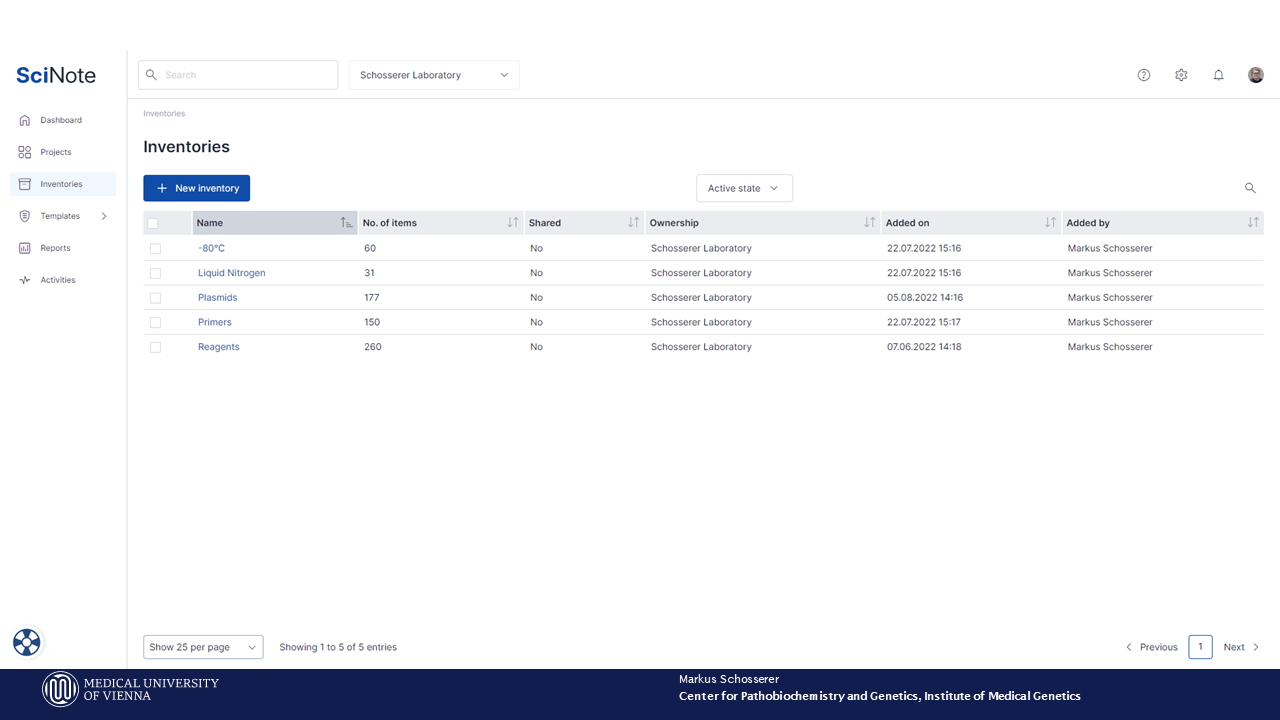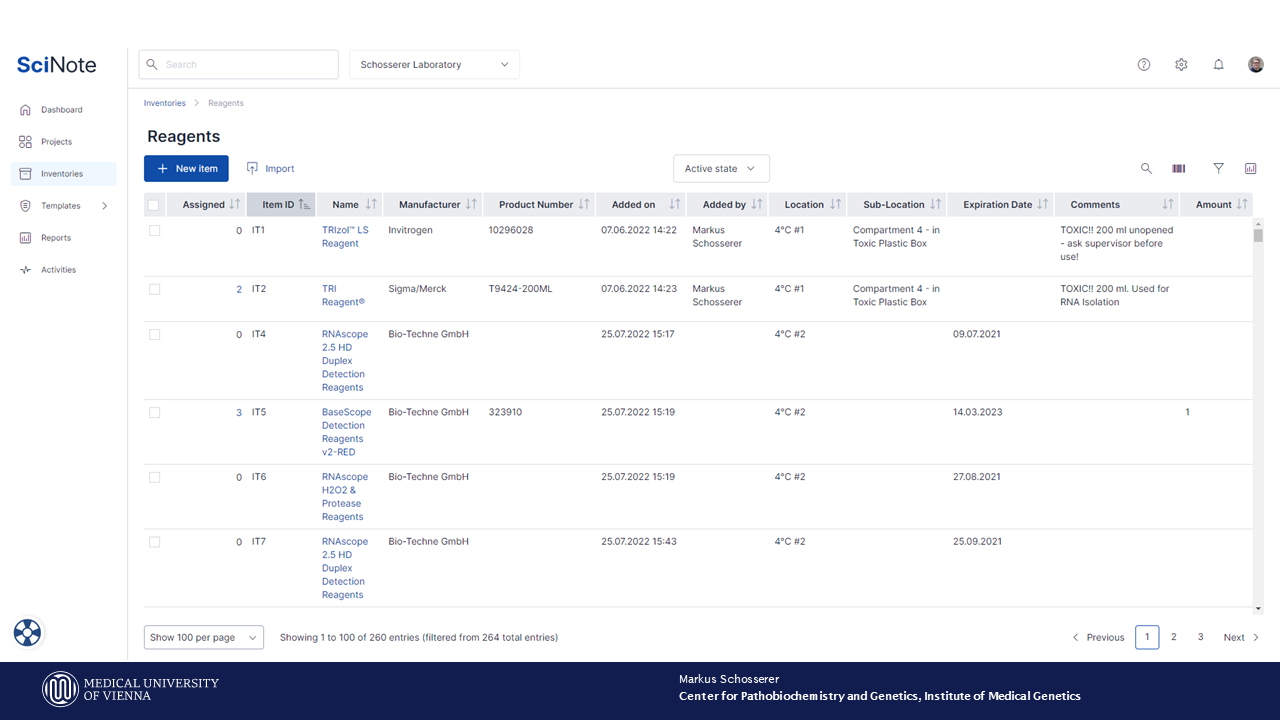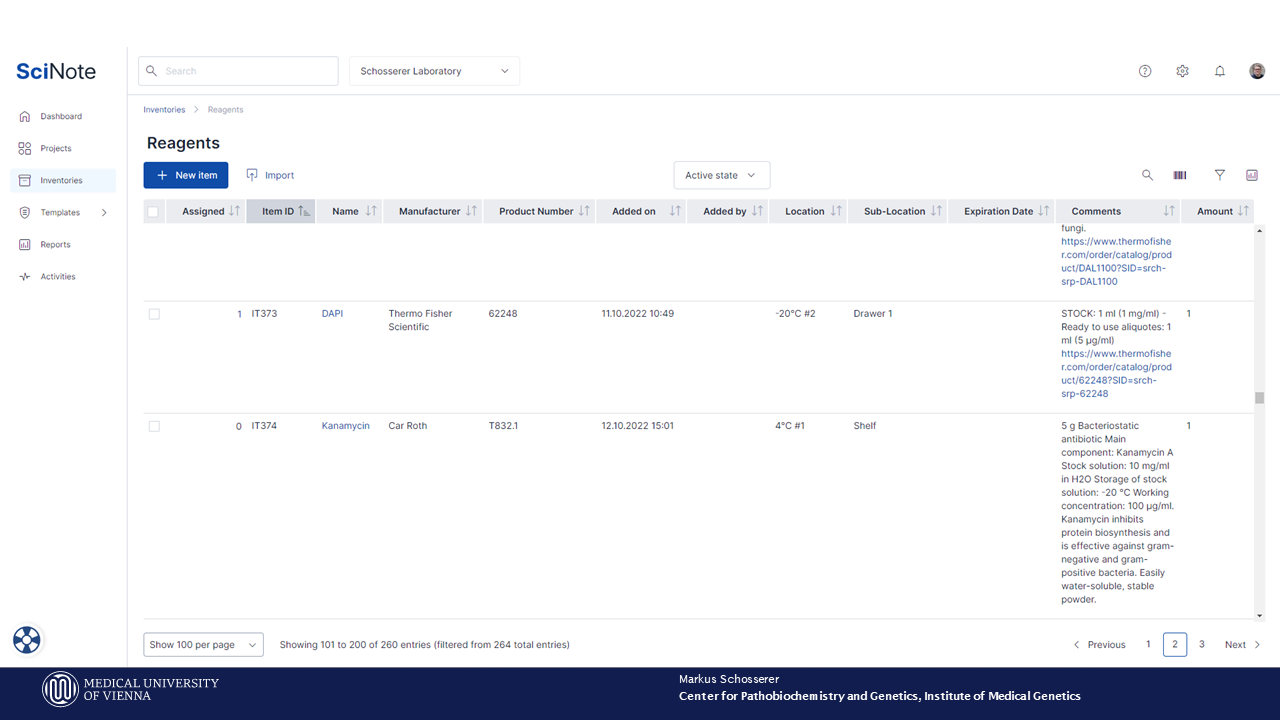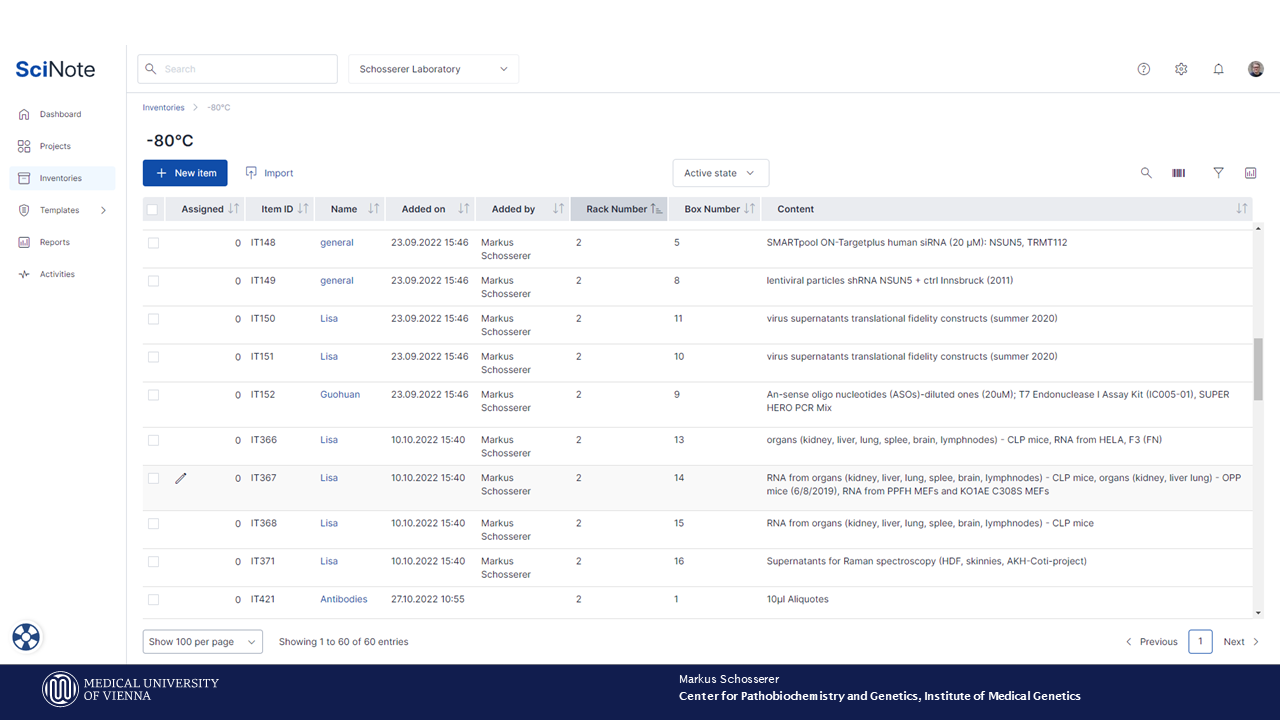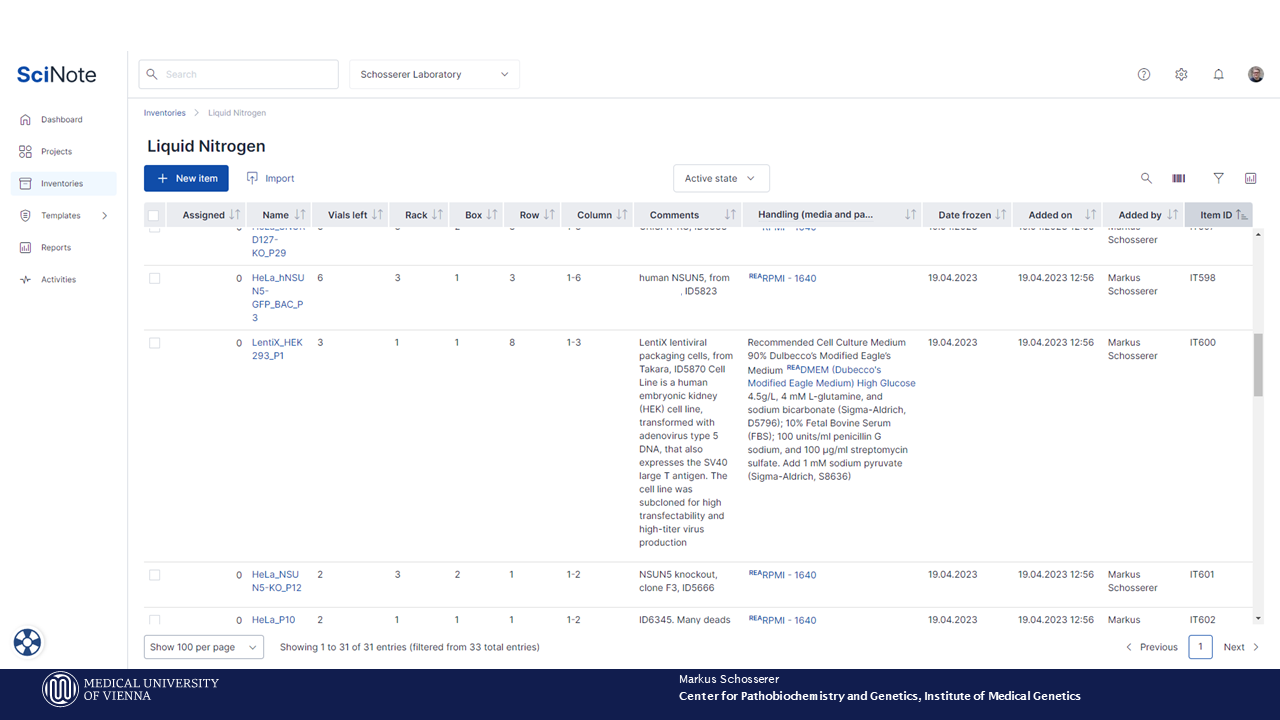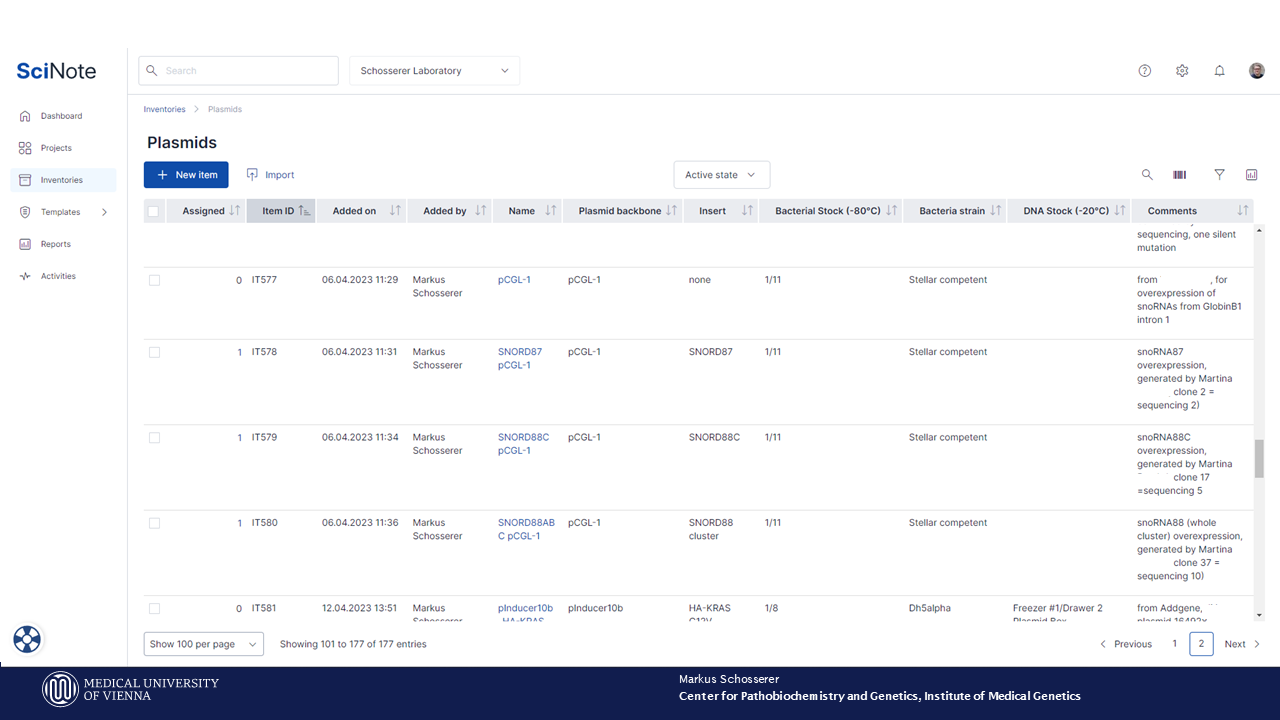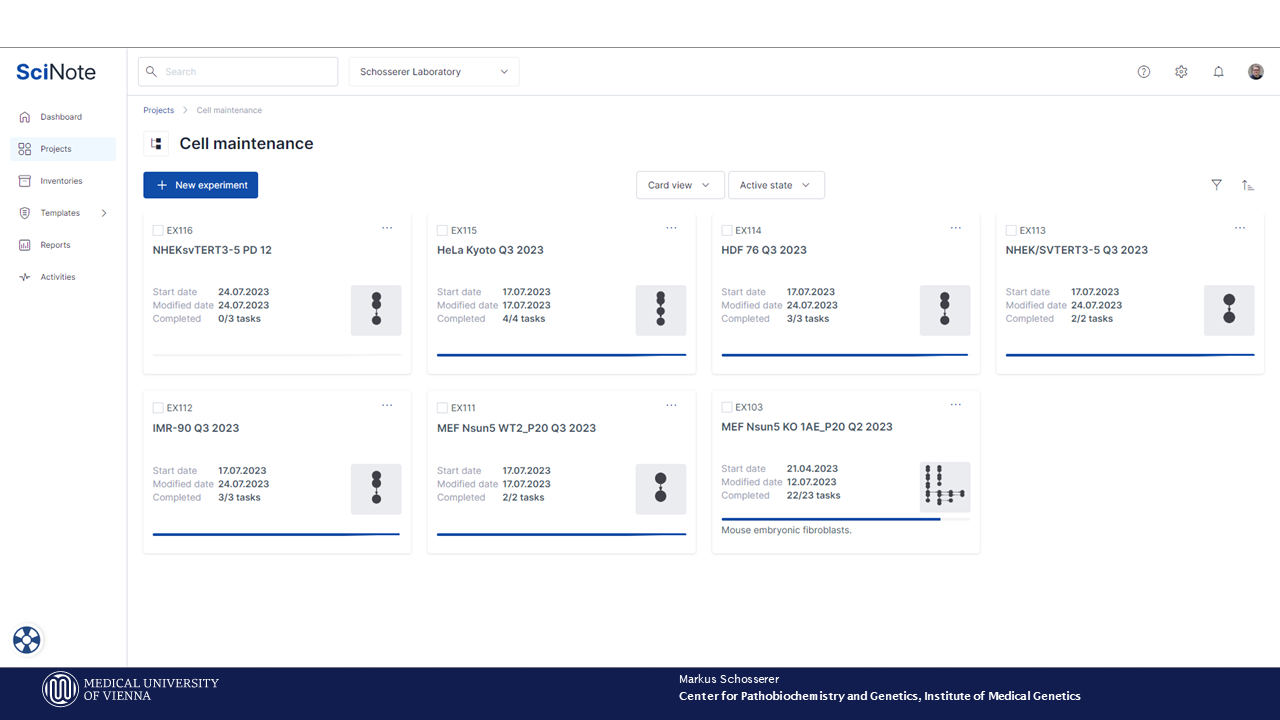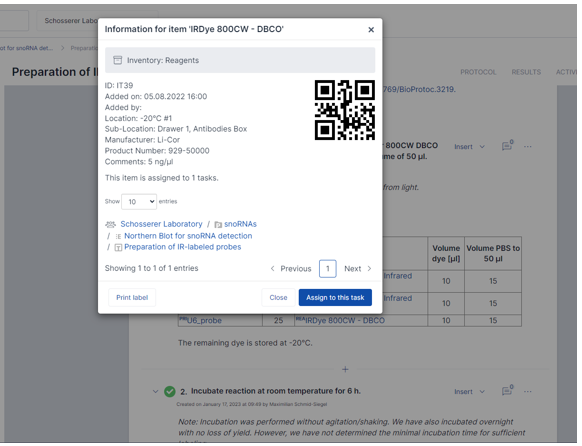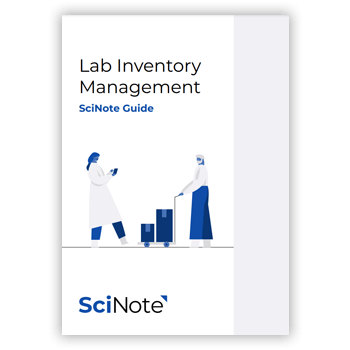Improve inventory management in a research lab with SciNote
Here’s how the Schosserer Lab (Medical University of Vienna) uses SciNote electronic lab notebook to improve its lab inventory management and ensure data traceability.
“We tested both the free and the paid/premium options. I already expected the premium version to be better, but I didn’t expect it to be that much better…in the end, SciNote really convinced us to spend a little bit of money to combine all the features we want – such as inventory management, the projects/experiments/tasks hierarchy structure, and a very nice workflow – in an ELN.”
Dr. Markus Schosserer, Principal Investigator, Medical University of Vienna
Table of contents:
About the research lab
Dr. Markus Schosserer has been a principal investigator at the Medical University of Vienna, Center for Pathobiochemistry and Genetics, Austria, since July 2022. He received his Ph.D. in Biotechnology from the University of Natural Resources and Life Sciences, Vienna, in 2012. His research interests lie in biogerontology, skin aging, cellular senescence, and RNA biology, particularly RNA modifications, ribosomes, and protein translation. Markus co-authored 43 papers and presented his work at several national and international conferences and seminars as an invited speaker. He won several poster and talk awards and collaborates actively with researchers in aging research and RNA/ribosome biology.
The Challenge
When Markus was a Postdoc/co-PI, he used many different methods to document and track data – from conventional paper lab notebooks for each team members (each PhD student could accumulate 8-9 notebooks during their projects), a WIKI-based protocol collection, Quartzy, Excel sheets, to other institutional online databases. However, this scattered approach made it challenging to retrieve information, especially during COVID when accessing old research data from paper notebooks left by past students became difficult.
Moreover, a significant problem was the lack of traceability for reagents used in the experiments. For example, in the case where several antibodies with the same target were used in the lab, there was no way of knowing which specific one a student had used in a particular experiment in a given year. This lack of traceability posed a considerable hindrance to the reproducibility and accuracy of the lab’s research findings.
The Solution
When Markus became an independent PI at the Medical University of Vienna, he was motivated to implement an electronic lab notebook (ELN) in his lab. They tested four different ELN solutions, both commercial and free, and discovered significant variations in their user interfaces and functionalities. Further, lab members had strong preferences and dislikes towards different ELNs, and some specialized solutions didn’t suit the lab’s diverse range of methods.
In the end, Markus decided to adopt SciNote as the lab’s ELN. It was not only his personal favorite, but it was also well-received by other team members. SciNote stood out for its clear structure, featuring Projects/Experiments/Tasks, graphical representation in flow charts, and integration of protocol databases and inventories with the ability to link all data effectively.
Watch the full presentation on how an electronic lab notebook can help you manage your inventories and ensure data traceability.
Key Takeways
Data migration takes time, but is well worth it.
The Schosserer Lab migrated protocols, inventories, and data from other systems or platforms into SciNote using the follow approaches:
Protocols from WIKI/Word files: Copy/paste
Converting individual protocol steps may require patience, but the effort is rewarding in the end. This feature allows lab members to interact with the protocol by checking off each step as they complete it during an experiment. This interactive process is even more beneficial when lab members use SciNote’s mobile app at the bench, which is the case with the Schosserer lab.
Inventories from different sources: Export (Excel or csv files) and import
Inventory data can be exported easily from platforms such as Quartzy. Other inventories in either Excel or csv formats can be uploaded directly into SciNote, making it rather straight forward to migrate inventories into SciNote’s built-in inventory management system.
Pro-tip: Individual items should be organized in lines and categories in columns. Make sure to carefully plan the structure of your new SciNote inventory (numbers, names, and data types of categories) before import.
Note: In the video, Markus mentioned that the protocol could only be updated by the creator of the protocol. This is no longer the case with SciNote’s recent feature update. Learn more.
Inventory management can be tailored based on lab needs
In the Schosserer Lab, each inventory item in SciNote includes essential details such as its name, the date it was added, and the name of the person who added it. There is also a comment field available to provide any additional information about the inventory item.
New columns are created to capture additional information, as follows:
Reagents
A general inventory to store all the lab’s reagents. Additional data categories (column titles) include name, manufacturer, product number, location of the reagent, expiration date, amount, and other comments.
Pro-tips:
- Do not use the “number” Column Type for the product number, as some product numbers consist of a combination of numbers and letters.
- Use the “drop-down” Column Type for locations of your reagents (if you have a limited set of locations set up) to allow for easy selection and to prevent errors. Add a sub-location column that includes text content to capture additional notes regarding the location to help lab members find the item.
- Add a “comments” column to provide additional information related to the reagent or to link to external documents and websites for the reagent.
- Files can also be uploaded to individual inventory items – the Schosserer Lab uses this now for uploading reagent data sheets.
-80°C
Additional data categories (columns titles) include names for different boxes (either general, or for specific team members), and row/rack/box numbers. Team members can add information in the “content” column to show what’s in their boxes.
Liquid Nitrogen
Similar to the -80°C inventory, data categories (column titles) include the name of the cell line, vials left, and rack/box/row numbers, with additional notes about the cell line, and also how to handle the cell line with links to culture media reagents in the SciNote inventory. By clicking on the smart annotation hyperlinks, you can find additional information about the specific culture media reagents used.
Plasmids
In addition to item ID, this inventory also includes information about the plasmid backbone, the insert, various bacterial stock, bacterial strain and DNA stock. The lab now also uses the file upload option to store the vector map for each plasmid in the inventory.
Smart annotation maximizes traceability of data
Smart annotation maximizes traceability of data The Schosserer Lab organizes data in the following way on the Project level:
- Manuscripts: each project reflects (roughly) each planned manuscript. Projects are archived after publication.
- Cell culture passaging: Projects are archived after each quarter
- Training materials: Projects include onboarding materials and manuals for instruments for new team members. (this might be better match for protocols)
Pro-tip: Think about when you would archive a project, as otherwise you will end up with a large number of projects.
Connecting inventory items to tasks or protocol templates enhances data traceability and provides a convenient way to access reagent information. When one clicks on the link, an information box will pop up, displaying the location of the reagent and additional details. This makes it easier to keep track of items and quickly find their storage spots.
Results
The Schosserer Lab adopted SciNote to enhance data traceability and inventory management. By migrating data from different platforms into SciNote, lab members can now benefit from interactive protocols and mobile apps while working at the bench. SciNote efficiently organizes various inventories, ensuring access to all critical information. Moreover, the smart annotation feature facilitates cross-referencing between inventories and tasks/protocols, significantly improving data traceability within the lab.
Download SciNote's Lab Inventory Management Guide
Get a complete overview of inventory management system in SciNote ELN.
Download the guide
